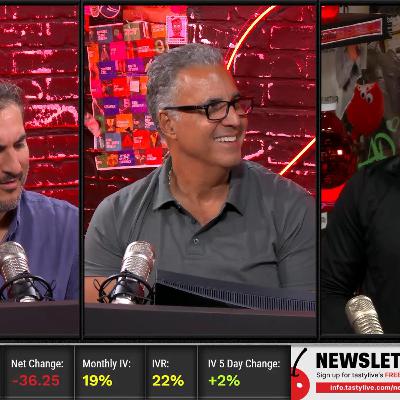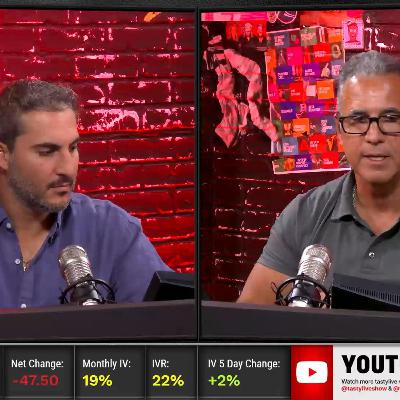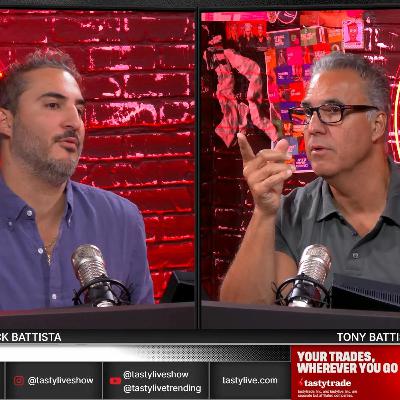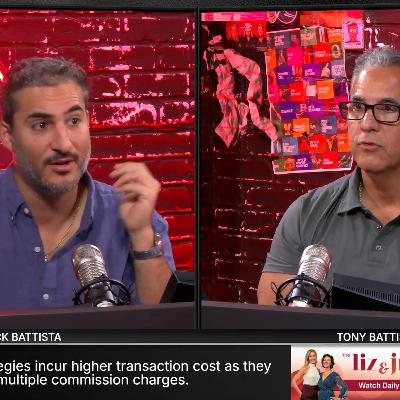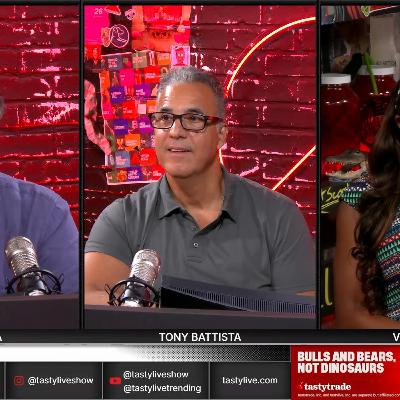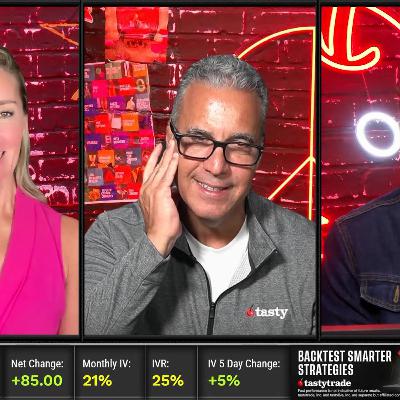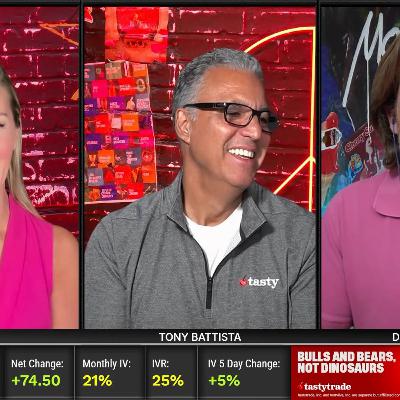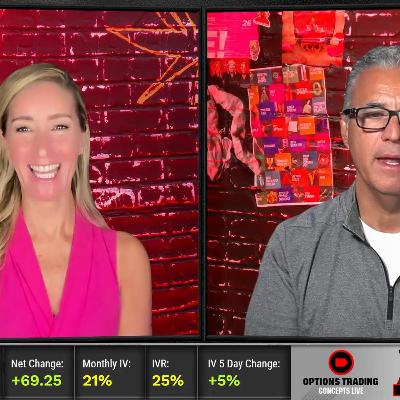Discover tastylive: tastylive
tastylive: tastylive
.png?width=3000&height=3000&fit=crop)
tastylive: tastylive
Author: tastylive
Subscribed: 1Played: 13Subscribe
Share
© ℗ & © copyright 2013 - 2025 tastylive. All Rights Reserved.
Description
Tom Sosnoff and Tony Battista, ex-floor traders, share decades of options trading experience for viewers interested in actionable trading ideas. Watch to increase your probability of success! Watch the Live Stream.
2293 Episodes
Reverse
Hosts Nick and Tony conducted a lively What's Your Assumption session responding to viewer trade ideas from around the globe, starting with Liz and Jenny's I-Bit bullish play where they recommended selling November 60 puts for $2+ given 62 IV rank. The standout trade was a GDX December 80 call/November 85 1x2 ratio for 80-cent debit - a "crab trade" giving Nick long gold exposure after admitting he "never got back to even in GDX." The Hood trade featured a 1-1-2 structure buying 130-120 put spread and selling two 105 puts at $1.14, with discussion of using those naked puts to later sell calls as an adjustment. Session highlights included advice for Ben in Bermuda who's up 25% on 50 Tesla 500 calls purchased at $4.80 (now $5.80), and a nostalgic "Slimmy" appearance maintaining his bearish Bitcoin-to-zero stance. The session ended with debate over managing their SPX zero-day put spread as markets rallied 50 points, with Nick ultimately closing the position against Tony's advice about rolling.
The skew index measures sentiment and tail-risk by tracking out-of-the-money puts and calls. It’s often seen as a fear gauge, but it reflects both upside and downside risk.
Typical values range from 110–180, with 146 as average. Historically, skew has shown little ability to predict SPX returns.
However, extreme skew levels often align with larger VIX moves. When VIX is low (10–14), surprises cause sharper reactions than in high-volatility periods.
Skew is worth monitoring, but offers limited trading signals. Key takeaway: high volatility overstates risk; low volatility understates it.
The market measure segment analyzed stop-loss strategies for spread trades, examining data from SPY options over 10 years. Research showed trades without stop losses had the highest average P&L and win rates compared to various stop-loss thresholds. For traders needing protection, the 50-70% range offered the best balance between risk mitigation and profitability.
Rather than exiting positions completely, selling the untested side during adverse moves can reduce delta exposure by 30-50%, keeping traders in the game while managing risk.
Hosts Nick and Tony discussed the historic precious metals rally while managing through a sharp market sell-off, with Nick closing profitable positions including a NVIDIA put diagonal that went from $7 to $10. The gold segment revealed the accelerating pace of thousand-dollar moves (only 207 days from $3,000 to $4,000 versus years for prior moves), though both hosts admitted hating trading these markets despite increased activity over the past two years. The correlation analysis showed gold and silver move together (0.8 correlation) but have near-zero correlation with S&P 500 on a day-to-day basis, with silver behaving more like a "risk-on" asset due to its industrial demand. Nick capitalized on volatility expansion, taking $60 out of an SPX zero-day spread despite E-minis recovering $10 from entry, demonstrating the power of vol contraction. The session ended with Nick closing profitable TastyFX positions in EUR/JPY and GBP/JPY after taking significant pain, while noting oil's decline to $58 (lowest since April/May) and emphasizing the need to actively trade this volatile environment.
In a data-rich market measure, analysis shows 2025 correlations between major assets are significantly higher than historic lows across the board. SPY and QQQ have reached "maxed out" correlation levels, suggesting unified market movement despite Friday's volatility.
Gold has returned to its classic hedge profile with near-zero or negative correlation to equities, while small caps closely track major indices, indicating broader risk-on participation. Tech sector cohesion remains strong but less extreme than during pandemic peaks in 2020-2022.
The research suggests traders should be mindful of correlations when constructing portfolios, potentially reducing position sizing during periods of unusually high correlation. Metals continue showing strength with silver up nearly 6%, while tech darlings like NVIDIA, Microsoft, and AI-related stocks post significant gains.
Dr. Jim emphasized the importance of assessing leverage differently for short versus long delta positions. For short delta portfolios, he recommends using a delta-theta ratio of approximately 0.5, adjusting theta levels based on market volatility (0.1-0.2% in low volatility, up to 0.5% in high volatility environments).
For long delta positions, he suggests measuring leverage relative to SPY, calculating beta-weighted delta as a multiple of portfolio size. A 1X leverage means portfolio delta exposure equals the notional value of equivalent SPY shares.
Most traders are likely over-leveraged without realizing it. Dr. Jim recommends beginners start with 1X leverage, with experienced traders typically comfortable in the 2-3X range.
Hosts Liz and Tony welcomed researcher Kai to dissect Friday's dramatic sell-off that erased the entire week's gains, with breaking news of OpenAI-Broadcom deal sending AVGO up $40 to $360. Liz admitted eating her words after declaring markets "complacent" at 9:59am just before the crash, noting there was "no buying pressure at all" after 10am. The Friday move sent expected moves surging from 1.1% to 2.5% for the current week (166 points), with IVR jumping across all asset classes - especially gold and Bitcoin which showed double the S&P's volatility expansion. Kai explained crypto's notoriously higher volatility (7% Bitcoin move wasn't even top 10 percentile historically) while noting the 18% intraday plunge wiped out heavily leveraged accounts. Liz finally celebrated her gold bullishness after 22 years of ridicule as the metal broke $4,000, while the upcoming week features major bank earnings starting Tuesday morning (JPM, GS, C, WF) and TSM Wednesday, with expiration week historically showing 16-up/11-down pattern favoring bulls into Friday.









